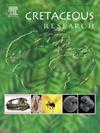Review and chronostratigraphic calibration of the Barremian–lower Aptian ostracod and pollen/spores biozonations of South Atlantic rift lacustrine formations (Gabon, Congo, Angola): impact on West African-Northeast Brazilian basin correlations
IF 1.7
3区 地球科学
Q1 GEOLOGY
引用次数: 0
Abstract
Geological syntheses conducted over the last ten years by TotalEnergies on South Atlantic rift basins have led to a reappraisal of the taxonomy and stratigraphy of lacustrine ostracods and terrestrial palynomorphs (spores, pollen) from the Barremian–lower Aptian of West Africa. The results of this revision, based on the acquisition and reinterpretation of data from 55 wells located in North Gabon, South Gabon, Congo and southern Angola-Kwanza basins, are summarized in this publication. The original ostracod and palynological stratigraphic charts have been significantly enhanced. For ostracods, five new zones and fifteen new subzones have been defined, completing the zonation. The taxonomic composition of the assemblages from the six former palynological zones has been clarified, and seven subzones have been described for the first time. Correlations between ostracod and spore-pollen zones of the West African margin, derived from the integration of Gabon and Congo data, have been established from bioevents now considered synchronous at rift basin scale. Their chronostratigraphic calibration, based on the latest International Chronostratigraphic Chart, is improved, supported by radiometric and isotopic data from Northeastern Brazil and the occurrence of distinctive palynomorphs, used as an indirect tool for extra-regional correlation. The present zonal scheme reveals remarkable correspondence between the distribution of ostracods and microfloras on both sides of the rift and reconciles the stratigraphic nomenclature used for the Barremian–lower Aptian in West Africa and Northeastern Brazil. This provides robust correlations between sedimentary formations of basins of the two conjugate margins, especially Recôncavo versus Gabon Interior Basin and South Gabon, Sergipe versus North Gabon, and in the south, Campos versus Kwanza.
南大西洋裂谷湖组(加蓬、刚果、安哥拉)巴雷米亚-下阿普提亚介形虫和花粉/孢子生物带的回顾和年代地层定标:对西非-巴西东北部盆地对比的影响
在过去的十年里,TotalEnergies对南大西洋裂谷盆地进行了地质综合研究,对西非巴雷米亚-阿普提亚盆地的湖相介形类和陆生孢子类(孢子、花粉)的分类和地层进行了重新评估。根据对北加蓬、南加蓬、刚果和安哥拉南部- kwanza盆地55口井的数据采集和重新解释,此次修订的结果总结在本出版物中。原始介形类和孢粉地层图得到了显著增强。对于介形虫,已经定义了5个新的区域和15个新的亚区域,完成了分区。澄清了6个原孢粉带组合的分类组成,并首次描述了7个亚带。西非边缘介形虫带和孢子花粉带之间的相关性来源于加蓬和刚果数据的整合,已经从现在认为在裂谷盆地尺度上同步的生物事件中建立起来。他们的年代地层校准基于最新的国际年代地层图,并得到了来自巴西东北部的放射性和同位素数据的支持,以及作为区域外对比的间接工具的独特地貌的出现。目前的地带性方案表明,裂谷两侧介形类和微生物区系的分布具有显著的一致性,并与西非巴雷米亚-下阿普tian和巴西东北部使用的地层命名法相一致。这为两个共轭边缘盆地的沉积地层提供了强有力的相关性,特别是Recôncavo与加蓬内陆盆地和南加蓬,Sergipe与北加蓬,以及南部的Campos与Kwanza。
本文章由计算机程序翻译,如有差异,请以英文原文为准。
求助全文
约1分钟内获得全文
求助全文
来源期刊

Cretaceous Research
地学-地质学
CiteScore
4.10
自引率
19.00%
发文量
235
审稿时长
12 weeks
期刊介绍:
Cretaceous Research provides a forum for the rapid publication of research on all aspects of the Cretaceous Period, including its boundaries with the Jurassic and Palaeogene. Authoritative papers reporting detailed investigations of Cretaceous stratigraphy and palaeontology, studies of regional geology, and reviews of recently published books are complemented by short communications of significant new findings.
Papers submitted to Cretaceous Research should place the research in a broad context, with emphasis placed towards our better understanding of the Cretaceous, that are therefore of interest to the diverse, international readership of the journal. Full length papers that focus solely on a local theme or area will not be accepted for publication; authors of short communications are encouraged to discuss how their findings are of relevance to the Cretaceous on a broad scale.
Research Areas include:
• Regional geology
• Stratigraphy and palaeontology
• Palaeobiology
• Palaeobiogeography
• Palaeoceanography
• Palaeoclimatology
• Evolutionary Palaeoecology
• Geochronology
• Global events.
 求助内容:
求助内容: 应助结果提醒方式:
应助结果提醒方式:


